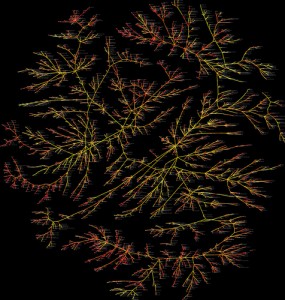Visualizing Information: The Netflix Network
Recently I came across the Visual Complexity website thanks to Adaptive Paths signposts for the week ending March 5th. A particular graphic by Christopher Hefele popped out at me called the NetFlix Similarity Map. Having written a paper on the intelligence of the Netflix recommender engine ‘Cinematch’ a couple semesters ago I found this visual to be particularly interesting.
It reminded me how important it is to visually display information. It took me weeks to try and craft into words the way the Cinematch engine’s algorithms worked. How the movies you rate are compared to how others rate movies, based on the types of movies that both you and another member like. Then how these ratings, and your shared tastes are collected and dumped into complex algorithms that can predict rather accurately what you will think of another movie you have not yet seen.
While it sound somewhat simple on the surface, there are many complicated issues to be handled. What if you rated a chick-flick you may have normally liked very poorly because you just got out of a bad relationship. What if you were having a really good time with friends, and rated an otherwise terrible movie 5 stars? And what about those cult classics like Napoleon Dynamite, that no one can seem to predict no matter how common your movie tastes? These had to be handled too.
All of these complexities can be hard to explain. It takes real work, cognitive spatial work to try and map out these relationships in your head. Not only the connectors that network the movies together, but the strength of those connections as well. Yet, with all this complexity one graphic sums it up brilliantly. It takes very little effort, and even less explanation. It is presented right in front of you requiring almost no work to put the pieces together. This is the value of presenting information visually.

Always like to read through these when I can. It’s intuitively obvious, and yet often we need to be reminded of the obvious to be smart about how we integrate it into our businesses.